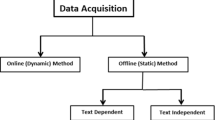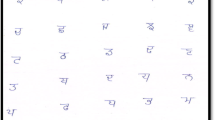Abstract
Biometrics encloses the science of measuring human body characteristics and authorizing the user based on biometric modalities. Physiological and behavioural biometrics identifiers are the two kinds of biometrics. The present article i.e. Gender Classification system (GCS) is one of the most challenging and serviceable application among the many behavioural biometric based artificial intelligence and machine learning systems. In the current experiment, handwriting modality has been in practice for the gender classification. For the experimental evaluation, a corpus consisting of 200 writers with offline handwriting samples from 100 males and 100 females in Gurumukhi script has been pre-processed using pre-processing algorithms, followed by extracting features by exploiting Zoning, Diagonal, Peak extent, Transition and hybridization of feature extraction algorithms. Based on the extracted features, gender is classified using classification techniques, namely, K-NN, Decision trees, Random Forest, and Adaptive boosting methodology. Performance of the experiment has been analysed using evaluation metrics such as classification accuracy, precision rate, area under the curve, root mean square error and false-positive rate. The proposed system achieves maximum accuracy of 94.6% for gender classification using hybridization of features based on offline handwriting in Gurumukhi script.










Similar content being viewed by others
References
Afifi M (2019) 11K hands: gender recognition and biometric identification using a large dataset of hand images. Multimed Tools Appl 78:20835–20854. https://doi.org/10.1007/s11042-019-7424-8
Aggarwal A, Singh K (2015) Handwritten Gurmukhi character recognition. 2015 International Conference on Computer, Communication and Control (IC4) 1–5
Aggarwal K, Sharma RK (2016) DFT based feature extraction technique for recognition of online handwritten Gurumukhi strokes. Proceed Int Conf Inventive Comput Technol (ICICT) 3:1–6
Ahmed M, Rasool AG, Afzal H, Siddiqi I (2017) Improving handwriting based gender classification using ensemble classifiers. Expert Syst Appl 85:158–168
Akbari Y, Nouri K, Sadri J, Djeddi C, Siddiqi I (2017) Wavelet-based gender detection on off-line handwritten documents using probabilistic finite state automata. Image Vis Comput 59:17–30
Aubin V, Mora M (2017) A new descriptor for person identity verification based on handwritten strokes off-line analysis. Expert Syst Appl 89:241–253
Bartle A, Zheng J. (2015). Gender classification with deep learning. Stanfordcs, 224d Course Project Report 1–7
Bi N, Suen CY, Nobile N, Tan J (2019) A multi-feature selection approach for gender identification of handwriting based on kernel mutual information. Pattern Recogn Lett 121:123–132
Botchkarev A (2019) Performance metrics (error measures) in machine learning regression, forecasting and prognostics: Properties and typology. Interdiscip J Inf, Knowl Manag 14:45–79 arXiv preprint arXiv: 1809.03006
Bouadjenek N, Nemmour H, Chibani Y (2014) “Local descriptors to improve off-line handwriting-based gender prediction. Proceedings of the 6th International Conference of Soft Computing and Pattern Recognition, pp. 43–47
Bouadjenek N, Nemmour H, Chibani Y (2015) “Histogram of Oriented Gradients for writer's gender, handedness and age prediction”, Proceedings of International Conference on Innovations in Intelligent Systems and Applications (INISTA), https://doi.org/10.1109/INISTA.2015.7276752
Cha SH, Srihari SN (2001) A priori algorithm for sub-category classification analysis of handwriting. In Proceedings of Sixth International Conference on Document Analysis and Recognition, p 1022–1025
Cordasco, G, Buonanno, M, Faundez-Zanuy, M, Riviello, MT, Sulem, LL, Esposito, A, (2020) “Gender identification through handwriting: an online approach, Proc. 11th IEEE international conference on cognitive info communications (CogInfoCom), 000197–000202, Mariehamn, Finland. https://doi.org/10.1109/CogInfoCom50765.2020.9237863
Cui Y, Pan T, Chen S, Zou X (2020) A gender classification method for Chinese mitten crab using deep convolutional neural network. Multimed Tools Appl 79:7669–7684
Dargan S, Kumar M (2019) “Writer Identification System for Indic and Non-Indic Scripts: State-of-the-Art Survey”, Archives of Computational Methods in Engineering, pp. 1283–1391. https://doi.org/10.1007/s11831-018-9278-z
Darmatasia, M Fanany I (2017) “Handwriting recognition on form document using Convolutional neural network and support vector machines (CNN-SVM)”, Proceedings of the 5th International Conference on Information and Communication Technology (ICoIC7), pp. 1–6
Fallah B, Khotanlou H (2016) “Identify personality parameter based on handwriting using neural network”, Artif Intell Robot, pp. 120–126
Garg A, Jindal MK, Singh A (2019) "Offline handwritten Gurumukhi character recognition: k-NN vs. SVM classifier", Int J Inf Technol, https://doi.org/10.1007/s41870-019-00398-4
Gader PD, Mohamed M, Chaing JH (1997) Handwritten word recognition with character and inter-character neural networks. IEEE Trans Sys Man, Cybern Part B: Cybern 27(1):158–164
Garain A, Ray B, Singh PK, Ahmadian A, Senu N, Sarkar R (2021) GRA_net: a deep learning model for classification of age and gender from facial images. IEEE Access 9:85672–85689
Gattal A, Djeddi C, Siddiqi I, Chibani Y (2018) Gender classification from online multi-script handwriting images using oriented basic image features (OBIF). Expert Syst Appl 99:155–167
Guerbai Y, Chibani Y, Hadjadji B (2017) Handwriting gender recognition system based on the one-class support vector machines. In 2017 Seventh International Conference on Image Processing Theory, Tools and Applications (IPTA) 1–5
Hull JJ (1994) “A database for handwritten text recognition research”, IEEE transactions on trans. Pattern Anal Mach Intell 16(5):550–554
Hussain R, Raza A, Siddiqi I, Khurshid K, Djeddi C (2015) A comprehensive survey of handwritten document benchmarks: structure, usage and evaluation. EURASIP Journal on Image and Video Processing 2015(1):1–24
Illouz E, David E, Netanyahu NS (2018) “Handwriting- based gender classification using end-to-end deep neural networks”, Proceed Int Conf Artif Neural Netw, pp.613–621
Jain AK, Nandakumar K, Ross A (2016) 50 years of biometric research: accomplishments, challenges, and opportunities. Pattern Recogn Lett 79:80–105
Katna R, Kalsi K, Gupta S, Yadav D, Yadav AK (2022) Machine learning based approaches for age and gender prediction from tweets. Multimedia Tools and Applications 81(19):27799–27817
Kumar M, Jindal MK, Sharma RK (2011) “K-nearest neighbour based offline handwritten Gurumukhi character recognition”, Proceedings of the International Conference on Image Information Processing, pp. 1–4
Kumar M, Sharma RK, Jindal MK (2013) A novel feature extraction technique for offline handwritten Gurmukhi character recognition. IETE J Res 59(6):687–691
Kumar M, Jindal MK, Sharma RK (2013) PCA-based offline handwritten character recognition system. SmartCR 3(5):346–357
Kumar M, Sharma RK, Jindal MK (2014) Efficient feature extraction techniques for offline handwritten Gurumukhi character recognition. Nat Acad Sci Lett 37:381–391
Kumar M, Jindal MK, Sharma RK (2014) A novel hierarchical technique for offline handwritten Gurmukhi character recognition. Nat Acad Sci Lett 37:567–572
Kumar M, Jindal MK, Sharma RK (2017) Offline handwritten Gurumukhi character recognition: analytical study of different transformations. Proceed Nat Acad Sci India Sect A: Phys Sci 87:137–143
Kumar M, Jindal MK, Sharma RK (2018) A novel framework for writer identification based on pre-segmented Gurumukhi characters. Sadhana 43:197. https://doi.org/10.1007/s12046-018-0966-z
Kumar S, Singh S, Kumar J et al (2022) Age and gender classification using Seg-net based architecture and machine learning. Multimed Tools Appl 81:42285–42308. https://doi.org/10.1007/s11042-021-11499-3
Levi G, Hassner T (2015) “Age and Gender Classification using Convolutional Neural Networks”, Proceedings of the IEEE Workshop on Analysis and Modeling of Faces and Gestures (AMFG), pp. 1–9
Liwicki M, Schlapbach A, Bunke H (2011) Automatic gender detection using online and offline information. Pattern Anal Applic 14(1):87–92
Maadeed AI, Hassaine A (2014) Automatic prediction of age, gender, and nationality in offline handwriting. EURASIP J Image Vid Process 1(10):1–10. https://doi.org/10.1186/1687-5281-2014-10
Maken P, Gupta A (2021) A method for automatic classification of gender based on text- independent handwriting. Multimed Tools Appl 80:24573–24602
Maken P, Gupta A (2021) A method for automatic classification of gender based on text-independent handwriting. Multimed Tools Appl 80:24573–24602
Mekhaznia, T, Djeddi, C, Sarkar, S, (2021) “Personality traits identification through handwriting analysis”, Communications in Computer and Information Science, 1322, Springer https://doi.org/10.1007/978-3-030-71804-6_12
Mirza A, Moetesum M, Siddiqi I, Djeddi C (2016) Gender classification from offline handwriting images using textural features. In 2016 15th International Conference on Frontiers in Handwriting Recognition (ICFHR) 395–398
Morera A, Sanchez A, Velez JF, Moreno A (2018) “Gender and handedness prediction from offline handwriting using convolutional neural networks”, Complexity, pp. 1–14
Mudjirahardjo P, Tan JK, Kim H, Ishikawa S (2015) “Comparison of feature extraction methods for head recognition”, Proceedings of the International Electronics Symposium (IES). https://doi.org/10.1109/ELECSYM.2015.7380826
P. Rai, P. Khanna, “An Efficient and Robust Gender Classification System”, Proceedings of the International Conference on Computational Intelligence and Communication Networks (CICN), pp. 254—261, 2015.
Rabaev I, Alkoran I, Wattad O, Litvak M (2022) Automatic gender and age classification from offline handwriting with BilinearResNet. Sensors 22(24):9650. https://doi.org/10.3390/s22249650
Rahmanian M, Shayegan MA (2021) Handwriting-based gender and handedness classification using convolutional neural networks. Multimed Tools Appl 80:35341–35364. https://doi.org/10.1007/s11042-020-10170-7
Sharma A , Kumar R, Sharma RK (2008) “Online Handwritten Gurumukhi Character Recognition Using Elastic Matching”, Proceedings of the 2008 Congress on Image and Signal Processing
Siddiqi I, Djeddi C, Raza A, Souici-Meslati L (2015) Automatic analysis of handwriting for gender classification. Pattern Anal Applic 18(4):887–899
Singh H, Sharma RK, Singh VP (2018) "Recognition of online unconstrained handwritten Gurumukhi characters based on finite state automata", Sadhana, vol. 43
Singh, AS (2019) "Online handwritten Gurumukhi words recognition", ACM Trans Asian Low- Resource Lang Inf Process, vol. 18, Article No. 21
Singh H, Sharma RK, Singh VP (2018) Efficient zone identification approach for the recognition of online handwritten Gurumukhi script. Neural Comput & Applic 31:3857–3968
Verma K, Sharma RK (2018) An efficient writing-zone identification technique for online handwritten Gurumukhi character recognition. Proceed Nat Acad Sci India Sect A: Phys Sci 88:297–307
Yang W, Sun C, Zheng W et al (2017) Gender classification using 3D statistical models. Multimed Tools Appl 76:4491–4503. https://doi.org/10.1007/s11042-016-3446-7
Youssef AE, Ibrahim AS, Abbott AL (2013) “Automated Gender identification for Arabic and English handwriting”, Proceedings of 5th International Conference on Imaging for Crime Detection and Prevention, pp. 1–6
Zarifi A, Naghavi M (2023) Gender identification of short text author using conceptual vectorization. Multimed Tools Appl 82:17097–17113. https://doi.org/10.1007/s11042-022-14141-y
Author information
Authors and Affiliations
Corresponding author
Ethics declarations
Ethical approval
The authors have created their own dataset for performing the experiments in the considered work.
Conflict of interest
The authors declare that they have no conflict of interest in this work.
Informed consent
All the authors are agreed for this submission.
Additional information
Publisher’s note
Springer Nature remains neutral with regard to jurisdictional claims in published maps and institutional affiliations.
Rights and permissions
Springer Nature or its licensor (e.g. a society or other partner) holds exclusive rights to this article under a publishing agreement with the author(s) or other rightsholder(s); author self-archiving of the accepted manuscript version of this article is solely governed by the terms of such publishing agreement and applicable law.
About this article
Cite this article
Dargan, S., Kumar, M., Mittal, A. et al. Handwriting-based gender classification using machine learning techniques. Multimed Tools Appl 83, 19871–19895 (2024). https://doi.org/10.1007/s11042-023-16354-1
Received:
Revised:
Accepted:
Published:
Issue Date:
DOI: https://doi.org/10.1007/s11042-023-16354-1




